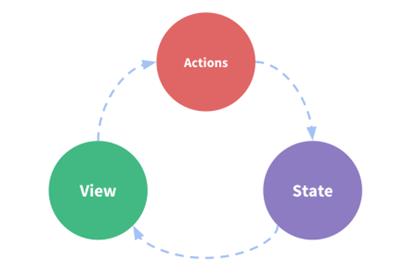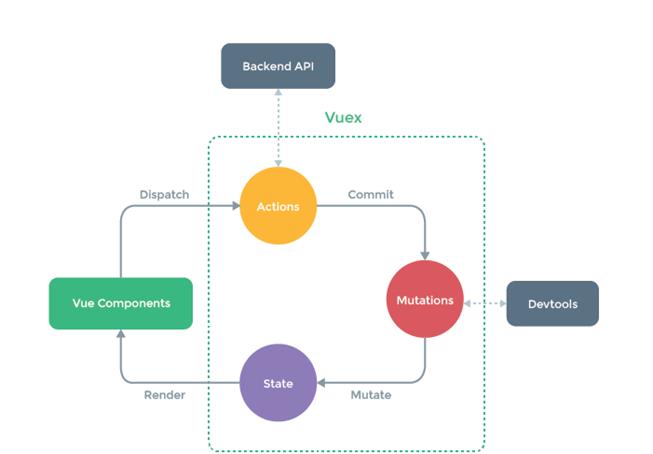Vue状态管理
Posted 编程小吉
tags:
篇首语:本文由小常识网(cha138.com)小编为大家整理,主要介绍了Vue状态管理相关的知识,希望对你有一定的参考价值。
状态管理
1.什么是状态管理?
由于状态零散地分布在许多组件和组件之间的交互中,大型应用复杂度也经常逐渐增长,所以 Vuex是Vue团队提供的一套组件状态管理维护的解决方案
-
作用
- 进一步完善了Vue基础代码功能
- 使Vue组件状态更加容易维护
- 为大型项目开发提供了强大的技术支持
-
使用
<script src="vue.js"></script> <script src="vuex.js"></script> <div id="app"> <p>this.$store.state.name</p> </div>var store = new Vuex.Store( state: name: '我是vuex' ) var vm = new Vue( el: '#app', store ) -
核心
每一个Vuex应用的核心就是store(仓库),即响应式容器,它用来定义应用中数据以及数据处理工具
- Vuex的状态存储是响应式的,当store中数据状态发生变化,那么页面中的store数据也发生相应变化
- 改变store中的状态的唯一途径就是显式地提交mutation,这样可以方便地跟踪每一个状态的变化
-
配置选项
var store = new Vuex.Store( state:, mutations:, actions:, modules:, plugins:, getters:, devtools:true )
2.下载使用
-
计算属性使用store<script src="vue.js"></script> <script src="https://unpkg.com/vuex@3.5.1/dist/vuex.js"></script> <div id="app"> <p>name</p> </div>var store = new Vuex.Store( state: name: '我是vuex' ) var vm = new Vue( el: '#app', store, computed: name () return this.$store.state.name ) -
mapState使用store<script src="vue.js"></script> <script src="https://unpkg.com/vuex@3.5.1/dist/vuex.js"></script> <div id="app"> <p>name</p> : <p>age</p> </div>var store = new Vuex.Store( state: name: '我是vuex', age: 20 ) var mapState = Vuex.mapState var vm = new Vue( el: '#app', store, computed: mapState( name: state => state.name, age: state => state.age ) )
3.管理模式
在Vue中,组件的状态变化是通过Vue单向数据流的设计理念实现的
-
单项数据流机制
State:驱动应用的数据源View:以声明方式将state映射到视图Actions:响应在View上的用户输入导致的状态变化

-
单项数据流示例
new Vue( // State data () return count: 0 , // View template: '<div> count </div>', // Actions methods: increment () this.count++ ) -
Vuex出现缘由
- 单项数据流机制增强了组件之间的独立性,但是当有多个组件共享某一个状态值时,这种数据流状态就会被破坏
- 为了数据维护更加方便,所以需要将共享状态抽离出来
- 而Vuex就是专门为Vue设计的状态管理库,以利用Vue的细粒度数据响应机制来进行高效的状态更新
-
Vuex工作流程

Actions中定义事件的回调方法,通过Dispatch触发事件,是异步执行的,专注于业务逻辑Mutations通过Commit提交,是同步执行的,专注于修改State中的全局状态数据
4.配置选项
-
actions
actions选项用于定义事件处理方法,用于处理state中的数据,类似于mutations,不同之处在于actions是异步执行的。事件处理函数可以接收commit对象,完成mutations提交。
-
参数传递<div id="app"> <button @click="see_mutations">查看mutations接收的参数</button> <button @click="see_actions">查看actions接收的参数</button> </div>var store = new Vuex.Store( state: name: 'lisi', , mutations: test(state) console.log(state) , actions: test1(context) console.log(context) , test2(context, param) console.log(param) , test3(context, param) console.log(param) ) var vm = new Vue( el: '#app', store, methods: see_mutations() this.$store.commit('test') , see_actions() this.$store.dispatch('test1') this.$store.dispatch('test2','传入的值') this.$store.dispatch("type":'test3',"content":'传入的值') ) -
案例演示<div id="app"> <button @click="add">计数器</button> <span v-text="count"></span> </div>var store = new Vuex.Store( state: count: 0, , mutations: change(state) state.count++ , actions: add(context) context.commit('change') ) var vm = new Vue( el: '#app', store, computed: count() return this.$store.state.count , methods: add() this.$store.dispatch('add') )
-
-
mutations
mutations中的方法主要用来对state进行数据操作,在组件中完成mutations提交就可以完成组件状态更新
-
参数传递<div id="app"> <button @click="send">发送参数</button> <span v-text="show"></span> </div>var store = new Vuex.Store( state: msg: '', , mutations: receive(state, param) state.msg = param ) var vm = new Vue( el: '#app', store, computed: show() return this.$store.state.msg , methods: send() this.$store.commit('receive','hello world') this.$store.commit("type":'receive',"message":'hello world') ) -
同步回调- 在调试组件状态时,mutations提交的日志信息都会被记录下来
- 触发mutations中的事件处理方法来更新页面状态的变化,这就是一种同步状态
- mutations本身的同步方法是同步执行,这样就可以记录当前状态的变化,同步到页面中
-
异步回调- 对于mutations事件处理方法中的诸如setTimeout这样的回调函数,那么当执行时任何回调函数中进行的状态改变都是不可追踪的
<div id="app"> <button @click="add">异步回调执行</button> <span v-text="count"></span> </div>var store = new Vuex.Store( state: count: 0 , mutations: receive(state) console.log(state) setTimeout(function() state.count++ ,1000) ) var vm = new Vue( el: '#app', store, computed: count() return this.$store.state.count , methods: add() this.$store.commit('receive') )
-
-
getters
store实例允许在store中定义getters计算属性,类似于Vue实例的computed
<div id="app"> <input @keyup.enter="search" v-model="name" placeholder="请输入商品名"/> <div v-text="good"></div> <ul v-for="good in goods" :key="good.name"> <li> <span v-text="good.name"></span>-<span v-text="good.price"></span> </li> </ul> </div>var store = new Vuex.Store( state: goods: [ "name":'商品1',"price":2000, "name":'商品2',"price":500, "name":'商品3',"price":1200 ], name: '' , mutations: change(state,name) state.name = name , getters: good: state => return state.goods.filter(good => good.name === state.name) ) var vm = new Vue( el: '#app', data: name: '' , computed: goods() return this.$store.state.goods , good() return this.$store.getters.good , methods: search() this.$store.commit('change',this.name) , store ) -
modules
modules用来在store实例中定义模块对象,在开发中页面组件存在多种状态,且都是通过单一状态树形式实现数据状态可跟踪的,Vue为了解决这种问题,提出了类似于模块化开发的方式对store对象仓库进行标准化管理。
const module1 = state: name: '模块1' const module2 = state: name: '模块2' var store = new Vuex.Store( modules: m1:module1, m2:module2 ) var vm = new Vue( el: '#app', store ) console.log(vm.$store.state.m1) console.log(vm.$store.state.m2) -
plugins
Vuex中的插件配置选项为plugins,插件本身为函数,函数接收参数store
const myPlugin = store => // 当store初始化后调用 store.subscribe((mutation,state) => // 每次mutation提交后调用,mutation格式为 type, payload console.log(mutation.type, mutation.payload) ) var store = new Vuex.Store( mutations: show(state) console.log(state) , plugins:[myPlugin] ) store.commit('show','message') -
devtools
**devtools选项用来设置是否在devtools调试工具中启用Vuex,devtools选项经常用在一个页面中存在多个store实例的情况 **
var store = new Vuex.Store( devtools:true )
5.状态管理中的API
-
模块注册
store实例对象提供了动态创建模块的接口,也就是
store.registerModule()方法,同时还可以使用store.unregisterModule()方法来卸载Modulevar store = new Vuex.Store() store.registerModule('myModule', state: name: '我是动态注册的Module' ) var vm = new Vue( el: '#app', store ) console.log(vm.$store.state.myModule.name) -
状态替换
用于对state数据状态进行操作,可以通过
store.replaceState()方法实现状态替换,该方法接收新的state对象用来在组件中展示新对象的状态。var store = new Vuex.Store( state: message: '修改前' ) var vm = new Vue( el: '#app', store ) console.log